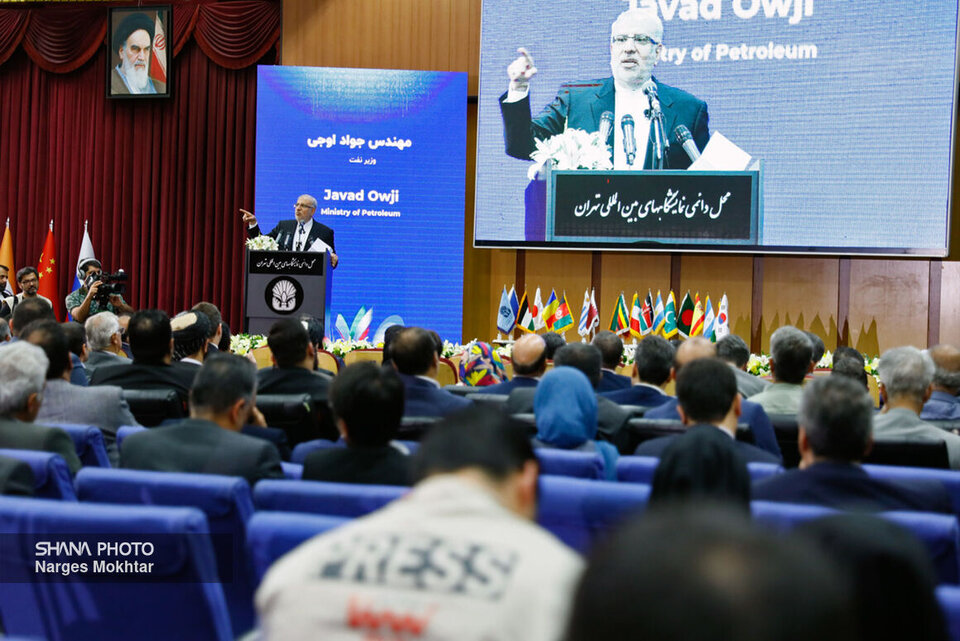Speaking at the opening ceremony of the 17th IranPlast International Exhibition at the Tehran International Permanent Fairground, the minister added 3.3 million barrels of oil currently produced in Iran per day are consumed inside the country or shipped abroad.
He said IranPlast International Exhibition is one of the top expositions in the region, adding the Oil Ministry’s umbrella is open to protect petrochemical companies and industrialists.
Shifting to the 13th (incumbent) administration’s determination to collect associated petroleum gas and use APG as petrochemical complexes’ feedstock, Owji vowed that his ministry will prevent the burning of Iran’s national wealth at gas flares.
Despite severe sanctions, this year’s exhibition has received great welcome, said the minister, adding more than 210 foreign and 640 Iranian companies have taken part in the expo, showing sanctions have been neutralized.
He said the key petrochemical industry boosts foreign currency inflow, fetching Iran nearly $16 billion in 2022.
Petrochemical industry ‘unsanctionable’
Given the world’s growing demand for its upstream and downstream products, petrochemical industry is “unsanctionable”, noted Owji.
He said petrochemicals constitute nearly 50 percent of non-oil exports and are produced in 70 complexes in Iran.
“The 13th administration and the Oil Ministry have outlined plans for boosting production in upstream sector and complete value chain,” continued the minister.
The Iranian complexes are producing a wide range of petrochemicals, including polymers, chemicals, fertilizers, aromatics, and hydrocarbons, stated the top official, adding, “The permit for producing 20 million tons of polymers in the country has been issued while the sector’s installed capacity is around 12 million tons per year and the real production is some 7 million tons.”
Polymer revenue 6 times higher if final products exported
Exporting one ton of unprocessed polymer generates a $900-$1,000 income while revenue from the sale of the same amount of finished product rises to $5,000-$6,000, said Owji.
The country has made considerable investments in the polymer sector, mentioned the minister, continuing that gas refineries produce propane and ethane, which are turned into propylene and ethylene and then into polypropylene and polyethylene.
He said IranPlast International Exhibition provides a good opportunity for exchanging views and experiences, generating synergy, and introducing petrochemical production capacities, which will pave the way for exporting technical and engineering services.
Pointing to the recent inauguration of Gachsaran petrochemical project, Owji said five petrochemical complexes will become operational by the end of the current Iranian calendar year (March 19, 2024), which will increase domestic capacity by five to six million tons.
According to him, unfinished projects worth $15 billion came on stream last year, and other oil projects having the same value will be launched this year and the executive operations of 14 projects worth $14 billion will begin.
Oil output up 1m bpd
The country’s oil production was around 2.3 million barrels per day (bpd) when the 13th administration took office, recalled the minister, saying the figure has now reached 3.3m bpd, and the produced oil is either used by domestic refineries or exported.
Considering the oil price hikes in international markets, the increase in Iran’s oil output is of greater significance as forecasts show that the oil price will top $100 by the end of 2023.
Iran had 87 million barrels of gas condensates in storage before the incumbent government took over, said Owji, adding the previous administration called for purchasing 12 more tankers to store them offshore, but the condensates were completely discharged thanks to the improvement of refineries and petrochemical plants’ processing systems and identification of new markets in the world by the 13th administration.
Shifting to production of catalysts, he said 85 catalysts have been already indigenized and other needed catalysts will be produced inside the country by the end of the current government’s term.
Extraterritorial petrochemical projects
Referring to exports of Iranian-made catalysts to European and neighboring states, Owji said Iran has already cooperated with other countries to renovate their refineries and now the ground has been prepared for Iran’s participation in extraterritorial petrochemical projects.
He pointed to petrochemical contracts signed during the president’s visit to Venezuela, explaining that the Latin American state’s installed petrochemical production capacity is 12 million tons per year but its real output hovers between 3 and 4 million tons.
Based on the agreements, Iran will help Venezuela achieve the target, the minister stated and continued Iran’s cooperation in overseas petrochemical projects will not be limited to Venezuela as these contracts will pave the way for finding the way into other countries.
Iran’s participation in extraterritorial petrochemical and refining projects also activates domestic manufacturers, noted Owji, saying, “Almost 2.8 million pieces of equipment were exported to a Latin American country for reconstructing an oil refinery last year and this year.”
U.S. fails to stop Iran oil production, exports
Shifting to Iran’s growing oil output and exports, Owji said “some say Americans have shown green light to Iran”, raising the question, “If it is true, why have they seized Iranian ships and imposed sanctions on companies frequently?”
The reality is that they failed to confront Iran’s oil and gas industry, said the minister, adding, “They did whatever they could to stop Iran’s oil production and exports, but the country’s crude output and exports have now hit the all-time high.”
He also pointed to the inauguration of Phase 11 of the South Pars (SP) gas field, the refinery of SP Phase 14, the second phase of Abadan Refinery, and collection of associated petroleum gas (APG), which not only helps protect the environment, but also supplies feedstock to petrochemical plants.
According to Owji, APG of 21 flares of East Karoun fields in southwestern province of Khuzestan will be collected by the end of current Iranian calendar year (March 19, 2024).
The gathered APG will be processed at the Persian Gulf Bidboland Gas Refinery, he explained and estimated that the volume of this region’s APG will be almost equal to that of one phase of the South Pars gas field.


Your Comment